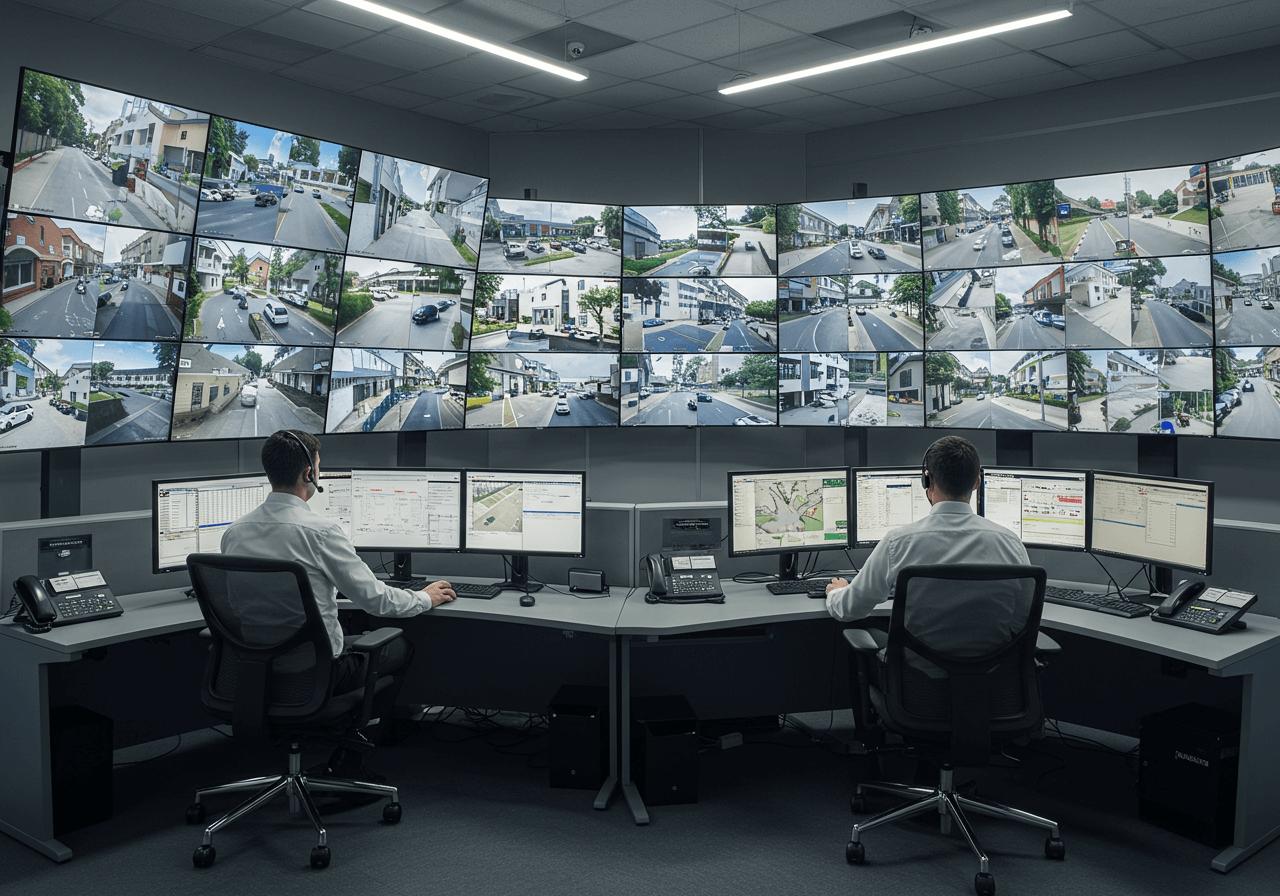An Alarm Receiving Centre (ARC) serves as the critical backbone of modern security systems, providing continuous alarm monitoring and rapid response to potential threats around the clock, 365 days a year. These specialised facilities operate as the vital communication bridge between alarm systems installed at properties (homes and businesses) and emergency responders, ensuring that when alarms trigger, highly trained operatives are ready to assess and act on the situation immediately.
TL;DR: Alarm Receiving Centres (ARCs) operate 24/7 to monitor security systems and coordinate emergency responses when alarms are triggered. Trained operatives follow strict alarm verification protocols to assess threats, contact appropriate responders, and provide important protection.
Key Takeaways:
- ARCs are staffed by highly trained professionals who monitor alarm systems 24/7/365.
- They handle various signals including intruder detection, fire alarms, panic alarms, and lone worker alerts.
- Operatives follow strict verification protocols to reduce false alarms and unnecessary callouts.
- ARCs provide significant coordination with emergency services (like initiating police response) when genuine threats are identified.
- Modern centres increasingly utilise advanced technology including video verification and AI for CCTV and alarm monitoring.
What is an Alarm Receiving Centre and Why Are They Critical to Security?
An Alarm Receiving Centre represents the central nervous system of security monitoring. These specialised facilities, often referred to simply as an ARC, house teams of certified security professionals who work around the clock to monitor alarm signals from thousands of connected properties. Unlike basic alarm systems that simply make noise, ARC-connected systems provide an active alarm response mechanism.
The critical function of an ARC is to serve as the essential link between detection and response. When an alarm activates – whether from a potential intruder, fire (from a fire alarm detector), medical emergency, or lone worker in distress (via lone worker devices) – the alarm signal is immediately transmitted to the ARC. According to data from Security Journal UK, many professionally installed security systems in the UK connect to these monitoring services, highlighting their importance. An independent alarm receiving centre often holds accreditation from bodies like the National Security Inspectorate (NSI, e.g., NSI Gold) or the Security Industry Authority (SIA), ensuring they meet highest industry standards.
ARCs don’t just receive signals as they take decisive action based on established protocols and the severity of the alarm. This includes verifying the nature of the alarm, contacting keyholders (via keyholding services), dispatching security personnel, and alerting emergency services when necessary. This provides homes and businesses with protection far beyond standalone alarms.

Inside the High-Tech Nerve Center: The ARC Environment
Stepping into a modern Alarm Receiving Centre reveals an environment like a high-security control room or call centre. Multiple monitoring stations with advanced technology allow operatives to track alerts. Large screens show real-time status updates.
ARCs are built with security redundancy. Physical security includes restricted access, and often BS (British Standard) compliance for their operations. They maintain business continuity through:
- Uninterruptible power supplies.
- Multiple communication channels.
- Redundant servers.
- Advanced cybersecurity (like Cyber Essentials Plus).
- Backup facilities.
The environment is designed for maximum concentration. Operatives work in shifts, essential for making split-second decisions in the event of an emergency.
Morning Shift: When Alarms Start the Day
The morning shift is busy for an ARC. Incoming operatives receive briefings. As businesses open, the ARC receives a surge of activity as security systems are deactivated. Operatives must quickly distinguish between:
- Legitimate deactivations.
- Potential forced entries.
- User errors causing false alarms.
- Technical malfunctions.
Operatives use alarm handling software displaying alerts, property details, and protocols. This ensures proper security while minimising disruption.
Types of Emergencies: From Break-ins to Medical Alerts
ARCs handle diverse emergency signals:
- Intruder alarm monitoring is foundational, using motion sensors, door/window contacts, and glass-break detectors.
- Fire alarm monitoring: responding to signals from smoke detectors, heat sensors, and sprinkler system activations. Rapid verification is essential. Many ARCs integrate with CCTV systems for visual confirmation before contacting the emergency services.
- Personal safety monitoring (lone worker safety / lone worker monitoring):
- Wearable panic alarms.
- Mobile apps with GPS.
- Fall detection devices.
- Timed check-in systems.
- Medical emergency monitoring for vulnerable individuals.
- Carbon monoxide detection.
The Verification Process: Separating Real Threats from False Alarms
When an alarm is triggered, ARC operatives follow a structured alarm verification workflow. This begins with signal analysis – which sensors activated, sequence, patterns.
For properties with CCTV monitoring, video verification provides confirmation. Operatives access live CCTV camera feeds to assess the situation. As detailed by Room banker, this reduces false dispatches.
Many ARCs offer audio intervention, allowing operatives to speak into the monitored premise. This can:
- Deter potential intruders.
- Communicate with people on-site.
- Verify false alarms without keyholder attendance.
- Provide instructions during evacuations.
Filtering false alarms ensures emergency services respond only to genuine emergencies, maintaining the integrity of security monitoring. The ARC cannot always prevent all false alarms, but processes significantly reduce them.
Emergency Response Coordination: When Seconds Count
Once an alarm is verified, ARC operatives shift into emergency response mode. For confirmed intrusions or intruder or fire events, operatives immediately contact law enforcement or the fire service, providing crucial details. This includes issuing a URN (Unique Reference Number, or unique reference numbers for police systems) if applicable for priority police response.
Simultaneously, the ARC will contact designated keyholders. This multi-layered approach informs stakeholders while emergency services are en route. Detailed documentation is maintained. Reliable ARCs deliver superior protection. This rapid response in an emergency is a key benefit of using an ARC.
Afternoon to Evening: Managing Commercial and Residential Security
Afternoon/evening shifts see a focus shift. Commercial properties close; residential monitoring takes precedence. Operatives monitor for:
- Proper system arming.
- Breaches during vulnerable periods.
- After-hours access requests.
- Unusual patterns.
Residential properties see increased activity. Operatives distinguish normal activity from threats. Evening shifts also handle manual testing requests.
The Future of ARCs: Technology Trends and Evolving Services
The ARC landscape evolves. Video verification improves accuracy. Modern video ARCs provide emergency responders with critical visual intelligence.
Integration with smart building systems is transformative. ARCs connect with:
- IoT sensors.
- Smart access control.
- Building automation for system management.
- Energy management.
AI and machine learning revolutionise alarm assessment, helping operatives distinguish genuine threats. This proactive approach is a hallmark of a good monitoring solution. The British Security Industry Association (BSIA) often promotes best practice and industry standards.
Remote/lone worker demand has expanded ARC services. Protection extends beyond fixed locations. This reflects the security industry’s commitment to innovation. The quality of service provided by an accredited ARC offers significant confidence.
Sources
safepointapp.com – What are alarm receiving centres
roombanker.com – What is ARC Alarm Receiving Centre
securityjournaluk.com – Alarm Receiving Centre
sirixmonitoring.com – Understanding Video Alarm Receiving Centre
barrybros.com – What is a monitored alarm and how do alarm receiving centres work

